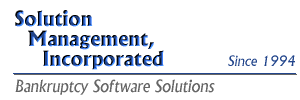Summary
EXP13 is an expense accounting package designed for the offices of Standing Chapter 13 Trustees. It includes Accounts Payable, General Ledger, and Fixed Asset modules, with a stock set of standard reports, integrated document management, and fine-grained access control for user accounts. This browser-based application relies entirely on open-source components, and can be deployed in any Trustee environment without imposing expensive prerequisites or compatibility problems.
Features
- General Ledger
-
The General Ledger module is the heart of the EXP13 system. Functions include general ledger posting and trial balance programs, with associated trial balance detail and summary standard reports. A budget maintenance program allows the Trustee to record and review fiscal year budget totals for all accounts, and the standard Monthly Receipt and Expense report allows the Trustee to easily track actual expenses against budget projections. Where applicable, the General Ledger module provides positive pay functionality for delivering encrypted positive pay data with payee name verification to the Trustee's bank.
- Accounts Payable
-
EXP13's Accounts Payable module gets the bills paid. Functions include payee maintenance, invoice data entry, invoice selection and check printing, clear/void outstanding checks, and payee activity query. Standard reports include Outstanding, Cleared and Voided Checks reports and a Payee Activity report.
- Fixed Assets
-
The Fixed Assets module allows the Trust operation to maintain an inventory database, organized into configurable categories and office locations. The inventory program presents a sortable overview of the inventory by fiscal year, with current items, items removed, and items purchased. The included Annual Inventory report summarizes the fiscal year current inventory and purchases and removals in a format suitable for the trust's annual audit. The inventory reconciliation program assists with reconciling the fiscal year's inventory purchases with general ledger transactions in specified fixed asset accounts.
- Document Management
-
EXP13's reporting interface allows any report to be generated in both print and PDF formats; PDF files generated through the reporting engine are automatically archived within EXP13. In addition, files from external sources can be archived in the system with configurable document types through manual upload, acquisition from local scanners, or acquisition from local network folders. The View Archived Documents program allows users to browse the document archive by archive date or document type.
- User Access Control
-
In order to facilitate a strong set of internal controls and strict division of duties, EXP13 employs a user access control matrix throughout the system, which defines each user's access to menus, programs and reports; at the file maintenance level, the matrix controls each user's access to the system's tables and to individual fields. Separate parameters determine access to view, add, or modify tables and fields. A matrix maintenance program lays out the matrix in an easily understood overview, making it simple for an administrator to maintain or modify user access. In some situations, user authentication can be integrated with the Trustee's case management system, mitigating the need to have additional accounts and passwords.
- Extensibility
-
EXP13 can be easily expanded by the Trustee to include custom tables for storing additional data, links to external programs or documents, and custom reports. New tables and reports can be linked to various menus in the system and maintained through EXP13's standard file maintenance routines and access control matrix. Custom reports, defined by simple XML files according to an easily-understood schema, can be developed by the Trustee, or by SMI upon request.

